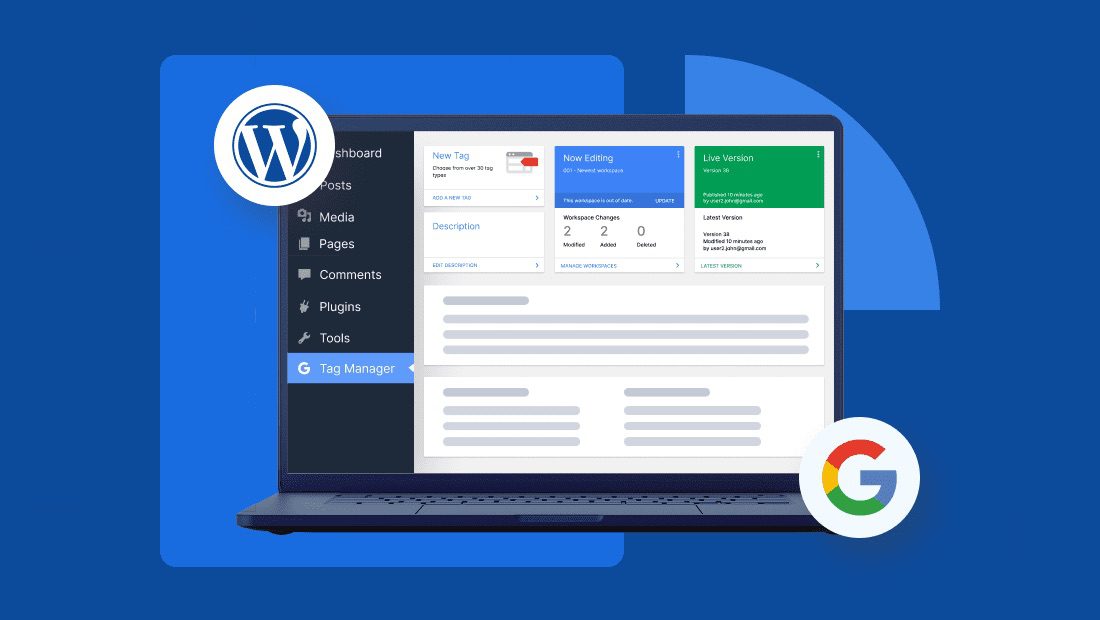Mastering Google Tag Manager
Whether you’re a digital marketing novice or a seasoned web analyst, understanding how to use Google Tag Manager (GTM) effectively can significantly boost your website management skills. Google Tag Manager is a free tool that makes it easier to manage and deploy marketing tags (snippets of code) on your website without having to modify the site code. But why should you care about using GTM, and how can you use it to your advantage?
Using GTM efficiently means you’ll be able to track visitor interactions, gather valuable data insights, and make informed decisions to improve your web strategies—all without grappling with complex code alterations. This flexibility not only saves you time and resources but also empowers you to adapt swiftly to the ever-changing digital landscape. Dive into this guide as we break down how to use Google Tag Manager, step by step. By the end, you’ll be ready to elevate your website tracking and analysis like never before.
So, grab your curiosity cap and let’s embark on this enlightening journey to harness the full power of Google Tag Manager. Keep reading to discover the key to unlocking streamlined, efficient, and potent website tracking!
The Importance of Google Tag Manager in Today’s Context
Introduction to Google Tag Manager
Google Tag Manager (GTM) is an essential tool for digital marketers and website owners. It allows users to easily manage and deploy marketing tags (snippets of code) on their websites and mobile apps without having to alter and redeploy the code itself. As businesses continue to expand their online presence, the ability to efficiently manage these tags becomes crucial.
Streamlining Workflow
One of the biggest advantages of Google Tag Manager is the way it streamlines workflows. By centralizing tag management, GTM removes the need for developers to manually add, update, or remove tags every time a marketing change is implemented. This not only saves time but also reduces dependency on the IT department, allowing marketers to execute campaigns more efficiently. According to a study by Econsultancy, automation tools like GTM can improve marketing efficiency by up to 20%.
Enhancing Website Performance
In today’s fast-paced digital world, website speed is more important than ever. Google Tag Manager can help by ensuring that tags are loaded asynchronously, which means they do not block other elements of the webpage from loading. This can lead to faster page load times and a better user experience. Faster websites often result in higher engagement and can improve search engine rankings, making GTM an indirect but powerful tool for SEO optimization.
Improving Data Accuracy and Insights
Accurate data gathering is crucial for making informed marketing decisions. GTM reduces the risk of errors when adding or removing tags manually, ensuring that data collection is more precise. With reliable data, marketers can gain better insights into user behavior, engagement, and conversion pathways. This can lead to more effective marketing strategies and improved return on investment (ROI).
Increasing Flexibility and Adaptability
The digital marketing landscape is rapidly changing, necessitating quick adjustments to marketing strategies. GTM provides businesses with the flexibility to test and deploy marketing strategies rapidly. Features like version control and tag templates make it easy to experiment with new tags without the fear of disrupting existing tracking. This adaptability gives businesses a competitive edge and allows them to respond faster to market trends and consumer behaviors.
Improving Collaboration
Google Tag Manager fosters better collaboration between different departments. By providing a workspace where multiple team members, such as marketers, developers, and data analysts, can contribute, GTM enhances communication and teamwork. The tool allows for a systematic workflow where changes can be previewed and tested before implementation, reducing miscommunications and errors.
Key Benefits of Google Tag Manager
- Simplified Tag Management: Manage all your website tags without needing to alter the code.
- Improved Website Performance: Enhance loading time by efficiently managing third-party tags.
- Increased Flexibility: Quickly create, test, and deploy marketing tags without developer intervention.
- Enhanced Tracking Capabilities: Implement advanced tracking features like event and conversion tracking.
- Version Control and Debugging: Easily manage versions and troubleshoot with built-in debugging tools.
- Integration with Google Services: Seamlessly connect with Google Analytics, Google Ads, and other services.
- Scalable for Any Size: Suitable for businesses of all sizes, from small websites to large enterprises.
- User-Friendly Interface: The intuitive dashboard makes it accessible for beginners and non-technical users.
Understanding Google Tag Manager
Learning how to use Google Tag Manager brings several advantages to both novice and expert digital marketers. It simplifies the process of managing marketing and analytics tags on your website, reducing the need for constant code changes by web developers. This benefit is particularly useful when launching new campaigns or making quick adjustments. For instance, a business running multiple ad campaigns can use Google Tag Manager to easily deploy and modify tracking codes without delay, which helps in timely analyzing the effectiveness of ads and making data-driven decisions.
Additionally, using Google Tag Manager can improve your website’s performance. By asynchronously loading tags, it prevents delays that could slow down the website. This feature is vital in e-commerce, where even a second of delay can affect customer experience and conversion rates. The enhanced tracking capabilities, like setting up tracking for button clicks and form submissions, allow businesses to gain deeper insights into user behaviors and improve their marketing strategies. Understanding how to use Google Tag Manager efficiently can ultimately lead to better marketing outcomes and business growth.
Common Challenges, Mistakes, or Myths Related to Google Tag Manager
Challenge: Understanding the Interface
Learning how to use Google Tag Manager can feel daunting at first because of its complex interface. The tool has many features and settings, which might seem overwhelming to beginners. However, by starting with the basics and gradually exploring more advanced options, you can become comfortable with Google Tag Manager. Online tutorials and the Google Tag Manager Help Center are good resources to help you navigate the interface.
Mistake: Not Using Predefined Variables
A common mistake in how to use Google Tag Manager is overlooking predefined variables. These variables, such as Page URL or Click ID, are built into the tool to make creating tags easier. Instead of coding variables from scratch, you can use these predefined options to streamline your setup and reduce the chance of errors.
Myth: Google Tag Manager Replaces a Developer
Some people believe that knowing how to use Google Tag Manager means they no longer need a developer. This is a myth. While Google Tag Manager makes adding and managing tags easier, complex implementations still require coding and technical expertise. Developers are essential for integrating advanced features and troubleshooting issues that may arise.
Challenge: Ensuring Correct Tag Firing
Another challenge in how to use Google Tag Manager is ensuring tags fire correctly on your website. Improperly configured triggers could lead to data discrepancies or missed conversions. It’s crucial to test all your tags thoroughly in different scenarios. The Preview Mode in Google Tag Manager allows you to see if tags are firing as intended before going live.
Mistake: Ignoring Version Control
Ignoring version control is a common mistake when learning how to use Google Tag Manager. Each time you make changes, you should create a new version in GTM. This practice helps you keep track of changes and easily revert to a previous version if something goes wrong. It’s a vital step in maintaining an organized and manageable tag implementation.
Myth: Only for Marketing Tags
Many people think Google Tag Manager is only for marketing tags. In reality, it can manage a variety of code snippets, including analytics and tracking pixels, as well as custom codes for different purposes. Understanding the full capability of Google Tag Manager can help teams beyond marketing achieve their tracking and implementation goals efficiently.
For additional insights and tutorials on how to use Google Tag Manager, you can visit the Google Tag Manager Help Center or explore Google Tag Manager’s YouTube Channel for video guides.
How to Use Google Tag Manager
Google Tag Manager (GTM) is a powerful tool that allows you to manage JavaScript and HTML tags used for tracking and analytics on websites. Here’s a step-by-step guide to help you get started with Google Tag Manager.
Step 1: Create a Google Tag Manager Account
- Sign Up/Log In: Visit the Google Tag Manager website. If you already have a Google account, click on “Sign In.” If not, create a new account.
- Create a New Account: Click on “Create Account.” Enter your account name, which is typically your company or website name.
- Set Up a Container: Name your container (e.g., website name) and choose where to use it: Web, iOS, Android, or AMP. Click “Create” to proceed.
- Agree to Terms: Review and accept the Google Tag Manager Terms of Service.
Step 2: Install Google Tag Manager on Your Website
- Access Code Snippets: After creating your container, GTM provides you with two code snippets.
- Install the Snippets: Place the first code snippet immediately after the opening
<head>tag on every page of your website. Place the second snippet immediately after the opening<body>tag. - Verify Installation: Use tools like Chrome’s Tag Assistant to ensure GTM is correctly installed.
Step 3: Create Tags, Triggers, and Variables
Create a New Tag
- Navigate to Tags: In the GTM dashboard, click on “Tags” in the left menu.
- Create a New Tag: Click on “New” and then on “Tag Configuration.”
- Choose Tag Type: Select the appropriate tag type (e.g., Google Analytics, AdWords, custom).
- Configure the Tag: Enter the necessary details (e.g., Tracking ID for Google Analytics).
- Set Up Triggers: Link your tag to an existing trigger or create a new one.
Create a New Trigger
- Navigate to Triggers: Click on “Triggers” in the left menu.
- Create a New Trigger: Click on “New” and then on “Trigger Configuration.”
- Choose Trigger Type: Select a trigger type (e.g., Page View, Click) and configure it.
- Save the Trigger: After configuration, save your trigger.
Create Variables
- Navigate to Variables: Click on “Variables” in the left menu.
- Enable Built-In Variables: Enable default variables GTM provides (e.g., Page URL, Click Classes).
- Create a New Variable: For custom requirements, create user-defined variables by clicking “New” in User-Defined Variables.
Step 4: Test Your Setup
- Enter Preview Mode: Click on “Preview” in the GTM Dashboard. This allows you to test your tags in a live environment without affecting all users.
- Analyze the Debug Panel: A debug panel will appear at the bottom of your website. It shows which tags fired successfully and which did not.
- Test Across Different Pages: Ensure your tags work as expected on multiple pages and scenarios.
Step 5: Publish Your Container
- Click Submit: Once you are satisfied with the setup in preview mode, click the “Submit” button in the GTM dashboard.
- Add Version Name and Description: Provide a descriptive name and details of what changes are included in this version.
- Publish: Click the “Publish” button to make your changes live.
Additional Resources
- Official Google Tag Manager Help: Google’s comprehensive guide for using GTM.
- Google Analytics Academy: GTM Fundamentals: Free online course to deepen your understanding.
Real-World Examples of Using Google Tag Manager
Implementing Google Tag Manager (GTM) effectively can transform how businesses track and analyze website data. Here, we dive into real-world examples and use cases that highlight its versatility across different industries.
1. eCommerce Success: The Case of ASOS
ASOS, a prominent online fashion retailer, leveraged Google Tag Manager to streamline their tracking and enhance their marketing strategies. The retailer integrated GTM to manage various tracking tags like Google Analytics, conversion tracking, and remarketing tags. This integration allowed ASOS to seamlessly implement new marketing campaigns and track user interactions without needing a developer for every small change.
Using GTM, ASOS efficiently analyzed data to improve user experience and refine their digital strategy, leading to increased conversion rates. Businesses can read more about similar strategies from Google’s Success Stories.
2. Healthcare & Insurance Insights: UnitedHealthcare
UnitedHealthcare used Google Tag Manager to maximize their targeting efforts and optimize their marketing campaigns. By implementing GTM, they were able to track custom metrics and attributes related to user engagement and funnel progression on their website.
This data empowered UnitedHealthcare to refine their customer journey, flagging drop-off points and tailoring marketing content to better suit their audience’s needs. Through efficient tag management and tracking, UnitedHealthcare enhanced their digital advertising strategies, significantly boosting ROI. Insights into similar utilizations can be found through Google Marketing Platform analytics case studies.
3. Education Innovations: University of California, San Diego (UCSD)
The University of California, San Diego, implemented Google Tag Manager to track a myriad of engagements across their digital platforms. With GTM, UCSD monitored how prospective and current students interacted with their extensive resources, including course catalogs and application forms.
By gathering in-depth data, the university’s marketing team could tailor their online content and campaigns to better engage with their audience, ultimately aiding in improving admission rates and student retention. For those in academia looking to adopt similar strategies, resources like Google for Education offer a starting point.
4. Non-Profit Enhancements: UNICEF
Utilizing GTM, UNICEF was able to optimize their online donation process by better understanding donor behavior and interaction patterns. By setting up event tracking and conversion goals, they discovered insights that led to more personalized and efficient donation funnels, directly contributing to a 30% increase in monthly online donations.
This usage stands as a testimony of how non-profits can harness the power of GTM for meaningful impact. More on their strategic implementations can be studied through UNICEF’s annual reports and digital strategies.
Google Tag Manager is a powerful tool that, when deployed effectively, offers significant benefits across various industries. From retail giants like ASOS to non-profit organizations such as UNICEF, its ability to enable data-driven decisions has proven invaluable. Whether you’re in eCommerce, healthcare, education, or non-profit sectors, implementing Google Tag Manager can sharpen your analytics and propel your organization forward. For more detailed insights and action steps, visit the official Google Tag Manager Resources.
Conclusion: Mastering How to Use Google Tag Manager
In today’s dynamic digital landscape, understanding how to use Google Tag Manager (GTM) is more important than ever. This powerful tool not only streamlines the management of your website’s tracking codes but also grants you the agility to make quick adjustments without delving into the complexities of your site’s codebase. As we have explored throughout this guide, how to use Google Tag Manager involves several key steps: setting up your account, configuring tags and triggers, and continuously testing and refining your setup for optimal performance.
Key Takeaways
-
Ease of Use: Google Tag Manager simplifies the process of managing tags, allowing you to focus more on strategic decisions and less on technical details.
-
Flexibility and Control: With its intuitive interface, GTM offers unparalleled flexibility, enabling marketers and developers to implement and modify tags swiftly and accurately.
-
Enhanced Performance: Streamlined tag management means faster website load times and an improved user experience, which are crucial for maintaining high engagement and conversion rates.
-
Improved Collaboration: GTM fosters better collaboration between marketing and IT departments by providing a common platform for tag management.
The Importance of Google Tag Manager
By learning how to use Google Tag Manager, you empower your digital marketing strategy with robust data collection capabilities. Mastering GTM not only contributes to a more efficient workflow but also enhances your analytical insight, enabling data-driven decision-making that can significantly benefit your business outcomes.
Let’s reiterate the importance of how to use Google Tag Manager: It is a pivotal skill for any digital marketer or developer aiming to maintain competitive advantage in a data-driven world. The ability to seamlessly implement and manage tags means greater adaptability in how you track, analyze, and respond to your audience’s behavior.
Final Thoughts
As you venture into using Google Tag Manager, remember that it is not just a tool—it is a gateway to a deeper understanding of your digital presence and your audience’s needs. Allow your curiosity to drive continual learning and experimentation, as GTM’s evolving features offer endless possibilities. Embrace how to use Google Tag Manager as a central component of your digital toolkit, and unlock new levels of marketing potential.
Remember, every tag is a stepping stone towards clearer insights and more impactful decisions. Keep pushing the boundaries of what GTM can do for your business, and watch as your marketing strategy transforms with precision and agility.




